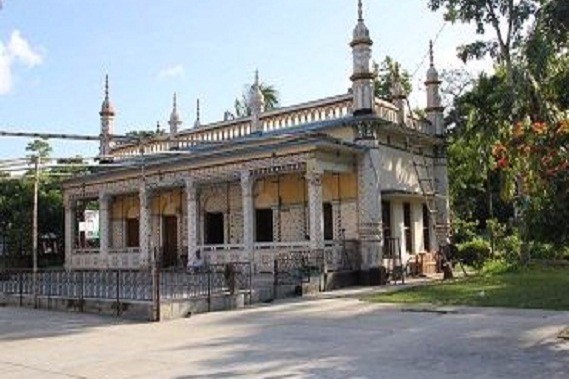Shariatpur District: A Hidden Gem of Bangladesh

 Exploring Shariatpur District: A Hidden Gem of Bangladesh-
Exploring Shariatpur District: A Hidden Gem of Bangladesh-
Shariatpur District is one of the lesser-known yet historically and culturally rich districts of Bangladesh. Located in the central part of the country, this district is famous for its serene landscapes, vibrant culture, and agricultural significance. Whether you are a history enthusiast, nature lover, or cultural explorer, Shariatpur District has something to offer.
In this blog, we will explore the history, geography, culture, economy, and top attractions of Shariatpur District, making it an essential guide for travelers and researchers alike.
History of Shariatpur District-
Shariatpur District has a rich history that dates back centuries. Initially part of the greater Faridpur District, it was established as an independent district in 1984. The district was named after Haji Shariatullah, a prominent Islamic reformer who played a crucial role in the Faraizi Movement against British rule in Bengal.
The region has witnessed significant historical events, including the struggles for independence during the British and Pakistani periods. Today, Shariatpur District stands as a testament to the resilience and progress of its people.
Geography and Climate-
Shariatpur District is located in the central part of Bangladesh, under the jurisdiction of the Dhaka Division. It is bordered by Munshiganj, Madaripur, Chandpur, and Barisal districts. The district is divided into six upazilas:
- Shariatpur Sadar
- Damudya
- Naria
- Bhedarganj
- Zanjira
- Gosairhat
The district experiences a tropical monsoon climate with hot, humid summers and mild winters. The mighty Padma River flows along its borders, making the region fertile and suitable for agriculture.
Culture and Traditions-
Shariatpur District boasts a rich cultural heritage that reflects the traditions of Bengal. The people here celebrate various religious and cultural festivals with enthusiasm. Major festivals include:
- Eid-ul-Fitr and Eid-ul-Adha: The most widely celebrated religious festivals.
- Pohela Boishakh: The Bengali New Year, marked by fairs and cultural programs.
- Durga Puja: A major Hindu festival celebrated with grandeur.
- Traditional Folk Music and Dance: Baul songs and Jari Sari performances are common in village fairs.
The local cuisine includes traditional Bengali dishes such as rice, fish, pitha (rice cakes), and sweets like roshogolla and chomchom.
Economy and Livelihood-
The economy of Shariatpur District is primarily agrarian, with agriculture being the main source of income for the majority of its population. The fertile lands along the Padma River support the cultivation of rice, jute, sugarcane, and various vegetables. Fishing is another significant economic activity, providing livelihood to many residents.
In recent years, small-scale industries, trade, and remittances from expatriates have contributed to the district’s economic growth. The government has also been investing in infrastructure and connectivity to enhance trade opportunities.
Top Tourist Attractions in Shariatpur District-
Despite being an offbeat destination, Shariatpur District has several attractions that captivate visitors. Here are some must-visit places:
1. Padma River Bank
The Padma River is one of the major attractions in the district. Tourists can enjoy scenic boat rides, fishing, and breathtaking sunset views along the riverbanks.
2. Naria Zamindar Bari
This historical palace was once home to the zamindars (landlords) of Naria. The structure showcases exquisite architectural details and gives a glimpse into the region’s aristocratic past.
3. Damudya Mosque
An ancient mosque that stands as an example of Islamic architectural heritage in the district.
4. Shariatpur Sadar Park
A popular recreational spot where families gather for picnics and outdoor activities.
5. Kartikpur Bazar
A bustling marketplace where locals trade fresh produce, fish, and handicrafts. It’s a great place to experience the daily life of Shariatpur residents.
Transportation and Accessibility-
Shariatpur District is well-connected by road and waterways. The district can be accessed from Dhaka via:
- Bus: Several bus services operate between Dhaka and Shariatpur, making the journey convenient.
- Ferry: Since the district is located along the Padma River, ferry services play a crucial role in transportation.
- Roadways: The government has been improving road infrastructure to ensure better connectivity with neighboring districts.
Future Prospects and Development-
With ongoing infrastructural developments, including the construction of bridges and improved road networks, Shariatpur District is on its way to becoming a more accessible and economically vibrant region. The government’s focus on digitalization and small-scale industries is expected to boost the district’s overall progress.
Conclusion-
Shariatpur District may not be a mainstream tourist destination, but it is a place full of historical significance, cultural vibrancy, and natural beauty. From its scenic riverbanks to its rich traditions, the district offers a unique glimpse into the heart of Bangladesh.
FAQs About Shariatpur District-
1. Where is Shariatpur District located? Shariatpur District is located in central Bangladesh under the Dhaka Division.
2. What is the main source of income in Shariatpur? Agriculture is the primary source of income, with fishing and small-scale industries also playing significant roles.
3. What are the major tourist attractions in Shariatpur? Some of the main attractions include the Padma River Bank, Naria Zamindar Bari, Damudya Mosque, and Shariatpur Sadar Park.
4. How can I reach Shariatpur District? You can reach Shariatpur via bus, ferry, and roadways from Dhaka and other neighboring districts.
5. What are the cultural highlights of Shariatpur? Shariatpur District is known for its traditional Bengali festivals, folk music, and delicious cuisine.